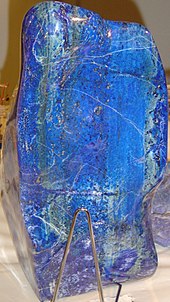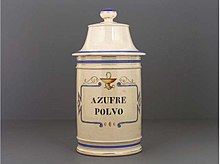Sulfur, 16S
 |

Spectral lines of sulfur
|
| General properties |
|---|
| Name, symbol | sulfur, S |
|---|
| Pronunciation |
sul-fər |
|---|
| Appearance | lemon yellow sintered microcrystals |
|---|
| Sulfur in the periodic table |
|---|
|
|
| Atomic number | 16 |
|---|
| Standard atomic weight (Ar) | 32.06[1] (32.059–32.076)[2] |
|---|
| Element category | polyatomic nonmetal |
|---|
| Group, block | group 16 (chalcogens), p-block |
|---|
| Period | period 3 |
|---|
| Electron configuration | [Ne] 3s2 3p4 |
|---|
| per shell | 2, 8, 6 |
|---|
| Physical properties |
|---|
| Phase | solid |
|---|
| Melting point | 388.36 K (115.21 °C, 239.38 °F) |
|---|
| Boiling point | 717.8 K (444.6 °C, 832.3 °F) |
|---|
| Density near r.t. | alpha: 2.07 g·cm−3
beta: 1.96 g·cm−3
gamma: 1.92 g·cm−3 |
|---|
| when liquid, at m.p. | 1.819 g·cm−3 |
|---|
| Critical point | 1314 K, 20.7 MPa |
|---|
| Heat of fusion | mono: 1.727 kJ·mol−1 |
|---|
| Heat of vaporization | mono: 45 kJ·mol−1 |
|---|
| Molar heat capacity | 22.75 J·mol−1·K−1 |
|---|
vapor pressure
| P (Pa) | 1 | 10 | 100 | 1 k | 10 k | 100 k |
| at T (K) | 375 | 408 | 449 | 508 | 591 | 717 |
|
| Atomic properties |
|---|
| Oxidation states | 6, 5, 4, 3, 2, 1, −1, −2 (a strongly acidic oxide) |
|---|
| Electronegativity | Pauling scale: 2.58 |
|---|
| Ionization energies | 1st: 999.6 kJ·mol−1
2nd: 2252 kJ·mol−1
3rd: 3357 kJ·mol−1
(more) |
|---|
| Covalent radius | 105±3 pm |
|---|
| Van der Waals radius | 180 pm |
|---|
| Miscellanea |
|---|
| Crystal structure | orthorhombic
|
|---|
| Thermal conductivity | 0.205 W·m−1·K−1(amorphous) |
|---|
| Electrical resistivity | 2×1015 Ω·m (at 20 °C) (amorphous) |
|---|
| Magnetic ordering | diamagnetic[3] |
|---|
| Bulk modulus | 7.7 GPa |
|---|
| Mohs hardness | 2.0 |
|---|
| CAS Registry Number | 7704-34-9 |
|---|
| History |
|---|
| Discovery | Chinese[4](before 2000 BCE) |
|---|
| Recognized as an element by | Antoine Lavoisier (1777) |
|---|
| Most stable isotopes |
|---|
| Main article: Isotopes of sulfur |
|
|
|
· references |
Sulfur occurs
naturally as the pure
element (
native sulfur) and as
sulfide and
sulfate minerals. Elemental sulfur crystals are commonly sought after by mineral collectors for their distinct, brightly colored
polyhedron shapes. Being abundant in native form, sulfur was known in ancient times, mentioned for its uses in
ancient India,
ancient Greece,
China and
Egypt. Fumes from burning sulfur were used as fumigants, and sulfur-containing medicinal mixtures were used as balms and antiparasitics. Sulfur is referred to in the
Bible as
brimstone (burn stone) in
English, with this name still used in several nonscientific tomes.
[5] It was needed to make the best quality of
black gunpowder. In 1777,
Antoine Lavoisier helped convince the scientific community that sulfur was a basic element rather than a compound.
Elemental sulfur was once extracted from
salt domes where it sometimes occurs in nearly pure form, but this method has been obsolete since the late 20th century. Today, almost all elemental sulfur is produced as a byproduct of removing sulfur-containing contaminants from
natural gas and
petroleum. The element's largest commercial use (after mostly being converted to
sulfuric acid) is to produce sulfate and phosphate
fertilizers, because of the relatively high requirement of plants for sulfur and phosphorus. Sulfuric acid is also a primary industrial chemical outside fertilizer manufacture. Other well-known uses for the element are in
matches,
insecticides and
fungicides. Many sulfur compounds are odoriferous, and the smell of odorized natural gas, skunk scent, grapefruit, and garlic is due to sulfur compounds.
Hydrogen sulfide produced by living organisms imparts the characteristic odor to rotting eggs and other biological processes.
Sulfur is an
essential element for all life, and is widely used in biochemical processes. In metabolic reactions, sulfur compounds serve as both fuels (
electron donors) and respiratory (oxygen-alternative) materials (
electron acceptors). Sulfur in organic form is present in the vitamins
biotin and
thiamine, the latter being named for the Greek word for sulfur. Sulfur is an important part of many enzymes and in antioxidant molecules like
glutathione and
thioredoxin. Organically bonded sulfur is a component of all proteins, as the
amino acids cysteine and
methionine.
Disulfide bonds are largely responsible for the mechanical strength and insolubility of the protein
keratin, found in outer skin, hair, and feathers, and the element contributes to their pungent odor when burned.
Spelling and etymology[edit]
Sulfur is historically a Latin word. The original Latin spelling was
sulpur, but this was
Hellenized to
sulphur; the form
sulfurappears toward the end of the Classical period. (The true Greek word for sulfur,
θεῖον, is the source of the international chemical prefix
thio-.) In 12th-century
Anglo-French, it was
sulfre; in the 14th century the Latin
ph was restored, for
sulphre; and by the 15th century the full Latin spelling was restored, for
sulfur, sulphur. The parallel
f~ph spellings continued in Britain until the 19th century, when the word was standardized as
sulphur.
[6] Sulfur was the form chosen in the United States, whereas Canada uses both. However, the
IUPAC adopted the spelling
sulfur in 1990, as did the Nomenclature Committee of the
Royal Society of Chemistry in 1992, restoring the spelling
sulfur to Britain.
[7] The Oxford Dictionaries note that "in chemistry ... the -f- spelling is now the standard form in all related words in the field in both British and US contexts."
[8]
The late Latin form also continues in the Romance languages: French
soufre, Italian
zolfo (from
solfo), Spanish
azufre (from
açufre, from earlier
çufre), Portuguese
enxofre (from
xofre). The Spanish and Portuguese forms are prefixed with the
Arabic article, despite not being Arabic words.
[6] The root has been traced back to reconstructed
proto-Indo-European *swépl̥ (genitive
*sulplós), a nominal derivative of
*swelp 'to burn', a lineage also preserved in the Germanic languages, where it is found for example as modern German
Schwefel, Dutch
zwavel, and Swedish
svavel, and as
Old English swefl.
[9]
Characteristics[edit]

When burned, sulfur melts to a blood-red liquid and emits a blue flame that is best observed in the dark.
Physical properties[edit]
Sulfur forms polyatomic molecules with different chemical formulas, with the best-known allotrope being
octasulfur, cyclo-S
8. The point group of cyclo-S
8 is D
4d and its dipole moment is 0 D.
[10] Octasulfur is a soft, bright-yellow solid with only a faint odor, similar to that of
matches.
[11] It melts at 115.21 °C (239.38 °F), boils at 444.6 °C (832.3 °F) and sublimes easily.
[5] At 95.2 °C (203.4 °F), below its melting temperature, cyclo-octasulfur changes from α-octasulfur to the β-
polymorph.
[12] The structure of the S
8 ring is virtually unchanged by this phase change, which affects the intermolecular interactions. Between its melting and boiling temperatures, octasulfur changes its allotrope again, turning from β-octasulfur to γ-sulfur, again accompanied by a lower density but increased
viscosity due to the formation of
polymers.
[12] At even higher temperatures, however, the viscosity decreases as depolymerization occurs. Molten sulfur assumes a dark red color above 200 °C (392 °F). The density of sulfur is about 2 g·cm
−3, depending on the allotrope; all of its stable allotropes are excellent electrical insulators.
Chemical properties[edit]
Sulfur burns with a blue flame concomitant with formation of
sulfur dioxide, notable for its peculiar suffocating odor. Sulfur is insoluble in water but soluble in
carbon disulfide and, to a lesser extent, in other nonpolar organic solvents, such as
benzene and
toluene. The first and the second ionization energies of sulfur are 999.6 and 2252 kJ·mol
−1, respectively. Despite such figures, the +2 oxidation state is rare, with +4 and +6 being more common. The fourth and sixth ionization energies are 4556 and 8495.8 kJ·mol
−1, the magnitude of the figures caused by electron transfer between orbitals; these states are only stable with strong oxidants as
fluorine,
oxygen, and
chlorine.
Allotropes[edit]

The structure of the cyclooctasulfur molecule, S
8.
Sulfur forms over 30 solid
allotropes, more than any other element.
[13] Besides S
8, several other rings are known.
[14] Removing one atom from the crown gives S
7, which is more deeply yellow than S
8.
HPLC analysis of "elemental sulfur" reveals an equilibrium mixture of mainly S
8, but with S
7 and small amounts of S
6.
[15] Larger rings have been prepared, including S
12 and S
18.
[16][17]
Amorphous or "plastic" sulfur is produced by rapid cooling of molten sulfur—for example, by pouring it into cold water.
X-ray crystallography studies show that the amorphous form may have a
helical structure with eight atoms per turn. The long coiled polymeric molecules make the brownish substance
elastic, and in bulk this form has the feel of crude rubber. This form is
metastable at room temperature and gradually reverts to crystalline molecular allotrope, which is no longer elastic. This process happens within a matter of hours to days, but can be rapidly catalyzed.
Isotopes[edit]
Sulfur has 25 known
isotopes, four of which are stable:
32S (95.02%),
33S (0.75%),
34S (4.21%), and
36S (0.02%). Other than
35S, with a
half-life of 87 days and formed in
cosmic ray spallation of
40Ar, the
radioactive isotopes of sulfur have half-lives less than 3 hours.
When
sulfide minerals are precipitated, isotopic equilibration among solids and liquid may cause small differences in the δS-34 values of co-genetic minerals. The differences between minerals can be used to estimate the temperature of equilibration. The δ
C-13 and δS-34 of coexisting
carbonate minerals and sulfides can be used to determine the
pH and oxygen
fugacity of the ore-bearing fluid during ore formation.
In most
forest ecosystems, sulfate is derived mostly from the atmosphere; weathering of ore minerals and evaporites contribute some sulfur. Sulfur with a distinctive isotopic composition has been used to identify pollution sources, and enriched sulfur has been added as a tracer in
hydrologic studies. Differences in the
natural abundances can be used in systems where there is sufficient variation in the
34S of ecosystem components.
Rocky Mountain lakes thought to be dominated by atmospheric sources of sulfate have been found to have different δ
34S values from lakes believed to be dominated by watershed sources of sulfate.
Natural occurrence[edit]

Most of the yellow and orange hues of
Io are due to elemental sulfur and sulfur compounds, produced by active volcanoes.

A man carrying sulfur blocks from
Kawah Ijen, a volcano in East Java, Indonesia, 2009
32S is created inside massive stars, at a depth where the temperature exceeds 2.5×10
9 K, by the
fusion of one nucleus of silicon plus one nucleus of helium.
[18] As this is part of the
alpha process that produces elements in abundance, sulfur is the 10th most common element in the universe.
Sulfur, usually as sulfide, is present in many types of
meteorites. Ordinary chondrites contain on average 2.1% sulfur, and carbonaceous chondrites may contain as much as 6.6%. It is normally present as
troilite (FeS), but there are exceptions, with carbonaceous chondrites containing free sulfur, sulfates and other sulfur compounds.
[19] The distinctive colors of
Jupiter's
volcanicmoon
Io are attributed to various forms of molten, solid and gaseous sulfur.
[20]
Common naturally occurring sulfur compounds include the
sulfide minerals, such as
pyrite (iron sulfide),
cinnabar (mercury sulfide),
galena (lead sulfide),
sphalerite (zinc sulfide) and
stibnite (antimony sulfide); and the sulfates, such as gypsum (calcium sulfate),
alunite(potassium aluminium sulfate), and
barite (barium sulfate). On Earth, just as upon Jupiter's moon Io, elemental sulfur occurs naturally in volcanic emissions, including emissions from
hydrothermal vents.
Production[edit]
Sulfur may be found by itself and historically was usually obtained in this way, while pyrite has been a source of sulfur via sulfuric acid.
[disputed – discuss][26] In volcanic regions in
Sicily, in ancient times, it was found on the surface of the Earth, and the
"Sicilian process" was used: sulfur deposits were piled and stacked in brick kilns built on sloping hillsides, with airspaces between them. Then, some sulfur was pulverized, spread over the stacked ore and ignited, causing the free sulfur to melt down the hills. Eventually the surface-borne deposits played out, and miners excavated veins that ultimately dotted the Sicilian landscape with labyrinthine mines. Mining was unmechanized and labor-intensive, with pickmen freeing the ore from the rock, and mine-boys or
carusi carrying baskets of ore to the surface, often through a mile or more of tunnels. Once the ore was at the surface, it was reduced and extracted in smelting ovens. The conditions in Sicilian sulfur mines were horrific, prompting
Booker T. Washington to write
"I am not prepared just now to say to what extent I believe in a physical hell in the next world, but a sulphur mine in Sicily is about the nearest thing to hell that I expect to see in this life.".
[27]
Today's sulfur production is as a side product of other industrial processes such as oil refining; in these processes, sulfur often occurs as undesired or detrimental compounds that are extracted and converted to elemental sulfur. As a mineral, native sulfur under salt domes is thought to be a fossil mineral resource, produced by the action of ancient bacteria on sulfate deposits. It was removed from such salt-dome mines mainly by the
Frasch process.
[25] In this method, superheated water was pumped into a native sulfur deposit to melt the sulfur, and then compressed air returned the 99.5% pure melted product to the surface. Throughout the 20th century this procedure produced elemental sulfur that required no further purification. However, due to a limited number of such sulfur deposits and the high cost of working them, this process for mining sulfur has not been employed in a major way anywhere in the world since 2002.
[28][29]

Sulfur recovered from hydrocarbons in
Alberta, stockpiled for shipment in North Vancouver,
B.C.
- R-S-R + 2 H2 → 2 RH + H2S
The resulting hydrogen sulfide from this process, and also as it occurs in natural gas, is converted into elemental sulfur by the
Claus process. This process entails oxidation of some hydrogen sulfide to sulfur dioxide and then the
comproportionation of the two:
[28][29]- 3 O2 + 2 H2S → 2 SO2 + 2 H2O
- SO2 + 2 H2S → 3 S + 2 H2O
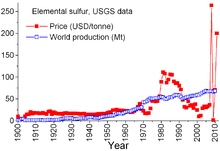
Production and price (US market) of elemental sulfur
Owing to the high sulfur content of the
Athabasca Oil Sands, stockpiles of elemental sulfur from this process now exist throughout
Alberta, Canada.
[30] Another way of storing sulfur is as a
binder for concrete, the resulting product having many desirable properties (see
sulfur concrete).
[31] Sulfur is still mined from surface deposits in poorer nations with volcanos, such as Indonesia, and worker conditions have not improved much since Booker T. Washington's days.
[32]
The world production of sulfur in 2011 amounted to 69 million tonnes (Mt), with more than 15 countries contributing more than 1 Mt each. Countries producing more than 5 Mt are China (9.6), US (8.8), Canada (7.1) and Russia (7.1).
[33] While the production has been slowly increasing from 1900 to 2010, the price was much less stable, especially in the 1980s and around 2010.
[34]
Compounds[edit]
Sulfur polycations[edit]
Sulfur polycations, S
82+, S
42+ and S
192+ are produced when sulfur is reacted with mild oxidising agents in a strongly acidic solution.
[35] The colored solutions produced by dissolving sulfur in
oleum were first reported as early as 1804 by C.F Bucholz, but the cause of the color and the structure of the polycations involved was only determined in the late 1960s. S
82+ is deep blue, S
42+ is yellow and S
192+ is red.
[12]
Sulfides[edit]
Treatment of sulfur with hydrogen gives
hydrogen sulfide. When dissolved in water, hydrogen sulfide is mildly acidic:
[5]- H2S
 HS− + H+
HS− + H+
Hydrogen sulfide gas and the hydrosulfide anion are extremely toxic to mammals, due to their inhibition of the oxygen-carrying capacity of hemoglobin and certain
cytochromes in a manner analogous to
cyanide and
azide (see below, under
precautions).
Reduction of elemental sulfur gives
polysulfides, which consist of chains of sulfur atoms terminated with S
− centers:
- 2 Na + S8 → Na2S8
This reaction highlights arguably the single most distinctive property of sulfur: its ability to catenate (bind to itself by formation of chains). Protonation of these polysulfide anions gives the
polysulfanes, H
2S
x where x = 2, 3, and 4.
[36] Ultimately reduction of sulfur gives sulfide salts:
- 16 Na + S8 → 8 Na2S
Oxides, oxoacids and oxoanions[edit]
The principal sulfur oxides are obtained by burning sulfur:
- S + O2 → SO2
- 2 SO2 + O2 → 2 SO3
-
-
Thiosulfate salts (
S
2O2−
3), sometimes referred as "hyposulfites", used in photographic fixing (HYPO) and as reducing agents, feature sulfur in two oxidation states.
Sodium dithionite (
Na
2S
2O
4), contains the more highly reducing
dithionite anion (
S
2O2−
4).
Halides and oxyhalides[edit]
Pnictides[edit]
Metal sulfides[edit]
The principal ores of copper, zinc, nickel, cobalt, molybdenum, and other metals are sulfides. These materials tend to be dark-colored
semiconductors that are not readily attacked by water or even many acids. They are formed, both geochemically and in the laboratory, by the reaction of hydrogen sulfide with metal salts. The mineral
galena (PbS) was the first demonstrated semiconductor and found a use as a signal
rectifier in the
cat's whiskers of early
crystal radios. The iron sulfide called
pyrite, the so-called "fool's gold," has the formula FeS
2.
[41] The upgrading of these ores, usually by
roasting, is costly and environmentally hazardous. Sulfur corrodes many metals via the process called
tarnishing.
Organic compounds[edit]
- Illustrative organosulfur compounds
Allicin, the active ingredient in garlic
-
-
-
-
-
-
Some of the main classes of sulfur-containing organic compounds include the following:
[42]
Compounds with carbon–sulfur multiple bonds are uncommon with the notable exception of
carbon disulfide, a volatile colorless liquid that is structurally similar to carbon dioxide. It is used as a reagent to make the polymer
rayon and many organosulfur compounds. Unlike
carbon monoxide,
carbon monosulfide is only stable as a dilute gas, as in the interstellar medium.
[43]
Organosulfur compounds are responsible for some of the unpleasant odors of decaying organic matter. They are used in the odoration of natural gas and cause the odor of garlic and skunk spray. Not all organic sulfur compounds smell unpleasant at all concentrations: the sulfur-containing
monoterpenoid grapefruit mercaptan in small concentrations is responsible for the characteristic scent of grapefruit, but has a generic thiol odor at larger concentrations.
Sulfur mustard, a potent
vesicant, was
used in
World War I as a disabling agent.
[44]
Sulfur-sulfur bonds are a structural component to stiffen rubber, in a way similar to the biological role of disulfide bridges to rigidify proteins (see biological below). In the most common type of industrial "curing" or hardening and strengthening of natural
rubber, elemental sulfur is heated with the rubber to the point that chemical reactions form
disulfide bridges between
isoprene units of the polymer. This process, patented in 1843, allowed rubber to become a major industrial product, especially automobile tires. Because of the heat and sulfur, the process was named
vulcanization, after the Roman god of the forge and volcanism.
History[edit]
Antiquity[edit]
Being abundantly available in native form, sulfur (
Latin sulphur) was known in ancient times and is referred to in the
Torah (
Genesis).
English translations of the Bible commonly referred to burning sulfur as "brimstone", giving rise to the term "
fire-and-brimstone"
sermons, in which listeners are reminded of the fate of
eternal damnation that await the unbelieving and unrepentant. It is from this part of the Bible that
Hell is implied to "smell of sulfur" (likely due to its association with volcanic activity). According to the
Ebers Papyrus, a sulfur ointment was used in ancient
Egypt to treat granular eyelids. Sulfur was used for fumigation in preclassical
Greece;
[45] this is mentioned in the
Odyssey.
[46] Pliny the Elder discusses sulfur in book 35 of his
Natural History, saying that its best-known source is the island of
Melos. He mentions its use for fumigation, medicine, and bleaching cloth.
[47]
A natural form of sulfur known as
shiliuhuang was known in China since the 6th century BC and found in
Hanzhong.
[48] By the 3rd century, the Chinese discovered that sulfur could be extracted from
pyrite.
[48] Chinese
Daoists were interested in sulfur's flammability and its reactivity with certain metals, yet its earliest practical uses were found in
traditional Chinese medicine.
[48] A
Song dynastymilitary treatise of 1044 AD described different formulas for Chinese
black powder, which is a mixture of
potassium nitrate (
KNO
3),
charcoal, and sulfur.
Indian alchemists, practitioners of "the science of mercury" (
sanskrit rasaśāstra, रसशास्त्र), wrote extensively about the use of sulfur in alchemical operations with mercury, from the eighth century AD onwards.
[49] In the
rasaśāstra tradition, sulfur is called "the smelly" (sanskrit gandhaka, गन्धक).
Early
European alchemists gave sulfur its own
alchemical symbol, a triangle at the top of a cross. In traditional skin treatment before the modern era of scientific medicine, elemental sulfur was used, mainly in creams, to alleviate conditions such as
scabies,
ringworm,
psoriasis,
eczema, and
acne. The mechanism of action is unknown—though elemental sulfur does oxidize slowly to sulfurous acid, which in turn (through the action of
sulfite) acts as a mild reducing and antibacterial agent.
[50][51][52]
Modern times[edit]
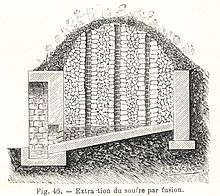
Sicilian kiln used to obtain sulfur from volcanic rock.
In 1777,
Antoine Lavoisier helped convince the scientific community that sulfur was an element, not a compound. Sulfur deposits in
Sicily were the dominant supply source for over half a century. Approximately 2000 tons per year of sulfur were imported into
Marseilles,
France for the production of
sulfuric acid via the
Leblanc process by the late 18th century. In
industrializing Britain, with the repeal of
tariffs on salt in 1824, demand for sulfur from Sicily surged upward. The increasing British control and exploitation of the mining, refining and transportation of the sulfur, coupled with the failure of this lucrative export to transform Sicily's backward and impoverished economy led to the 'Sulfur Crisis' of 1840, when
King Ferdinand II gave a monopoly of the sulfur industry to a French firm, violating an earlier 1816 trade agreement with Britain. A peaceful negotiated solution was eventually mediated by France.
[53][54]
In the late 18th century,
furniture makers used molten sulfur to produce decorative
inlays in their craft. Because of the
sulfur dioxideproduced during the process of melting sulfur, the craft of sulfur inlays was soon abandoned. Molten sulfur is sometimes still used for setting steel bolts into drilled concrete holes where high shock resistance is desired for floor-mounted equipment attachment points. Pure powdered sulfur was used as a medicinal tonic and laxative.
[25] With the advent of the
contact process, the majority of sulfur today is used to make
sulfuric acid for a wide range of uses, particularly fertilizer.
[56]
Applications[edit]
Sulfuric acid[edit]
Elemental sulfur is mainly used as a precursor to other chemicals. Approximately 85% (1989) is converted to
sulfuric acid (
H2SO
4):
- 2 S + 3 O2 + 2 H2O → 2 H2SO4

Sulfuric acid production in 2000
Because of its importance, sulfuric acid was considered an excellent indicator of a country's industrial well-being.
[57] For example with 32.5 million tonnes in 2010, the United States produces more sulfuric acid every year than any other inorganic industrial chemical.
[34] The principal use for the acid is the extraction of phosphate ores for the production of fertilizer manufacturing. Other applications of sulfuric acid include oil refining, wastewater processing, and mineral extraction.
[25]
Other large-scale sulfur chemicals[edit]
Fertilizer[edit]
Sulfur is increasingly used as a component of
fertilizers. The most important form of sulfur for fertilizer is the mineral
calcium sulfate. Elemental sulfur is
hydrophobic (that is, it is not soluble in water) and, therefore, cannot be directly utilized by plants. Over time, soil bacteria can convert it to soluble derivatives, which can then be utilized by plants. Sulfur improves the use efficiency of other essential plant nutrients, particularly nitrogen and phosphorus.
[58] Biologically produced sulfur particles are naturally hydrophilic due to a biopolymer coating. This sulfur is, therefore, easier to disperse over the land (via spraying as a diluted slurry), and results in a faster release.
Plant requirements for sulfur are equal to or exceed those for phosphorus. It is one of the major nutrients essential for plant growth, root nodule formation of legumes and plants protection mechanisms. Sulfur deficiency has become widespread in many countries in Europe.
[59][60][61] Because atmospheric inputs of sulfur continue to decrease, the deficit in the sulfur input/output is likely to increase, unless sulfur fertilizers are used.
Fine chemicals[edit]
Fungicide and pesticide[edit]
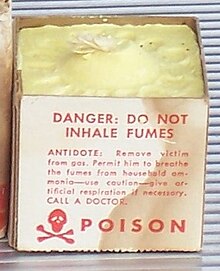
Sulfur candle originally sold for home fumigation
Elemental sulfur is one of the oldest fungicides and pesticides. "Dusting sulfur," elemental sulfur in powdered form, is a common fungicide for grapes, strawberry, many vegetables and several other crops. It has a good efficacy against a wide range of powdery mildew diseases as well as black spot. In organic production, sulfur is the most important fungicide. It is the only fungicide used in
organically farmed apple production against the main disease
apple scab under colder conditions. Biosulfur (biologically produced elemental sulfur with hydrophilic characteristics) can be used well for these applications.
Standard-formulation dusting sulfur is applied to crops with a sulfur duster or from a dusting plane. Wettable sulfur is the commercial name for dusting sulfur formulated with additional ingredients to make it water
miscible.
[62][63] It has similar applications and is used as a
fungicide against
mildew and other mold-related problems with plants and soil.
Elemental sulfur powder is used as an "
organic" (i.e. "green")
insecticide (actually an
acaricide) against
ticks and
mites. A common method of use is to dust clothing or limbs with sulfur powder.
Diluted solutions of
lime sulfur (made by combinding
calcium hydroxide with elemental sulfur in water), are used as a dip for pets to destroy
ringworm (fungus),
mange and other
dermatoses and
parasites. Sulfur candles consist of almost pure sulfur in blocks or pellets that are burned to
fumigate structures. It is no longer used in the home due to the toxicity of the products of combustion.
Bactericide in winemaking and food preservation[edit]
Small amounts of
sulfur dioxide gas addition (or equivalent
potassium metabisulfite addition) to fermented wine to produce traces of
sulfurous acid (produced when SO
2 reacts with water) and its
sulfite salts in the mixture, has been called "the most powerful tool in winemaking."
[64] After the yeast-fermentation stage in
winemaking, sulfites absorb oxygen and inhibit
aerobic bacterial growth that otherwise would turn ethanol into acetic acid, souring the wine. Without this preservative step, indefinite refrigeration of the product before consumption is usually required. Similar methods go back into antiquity but modern historical mentions of the practice go to the fifteenth century. The practice is used by large industrial wine producers and small organic wine producers alike.
Sulfur dioxide and various sulfites have been used for their antioxidant antibacterial preservative properties in many other parts of the food industry also. The practice has declined since reports of an allergy-like reaction of some persons to sulfites in foods.
Pharmaceutical use[edit]
Sulfur is used in pharmaceutical skin preparations for the treatment of
acne and other conditions. it acts as a
keratolytic agent and also kills bacteria, fungi,
scabies mites and other parasites.
[65] Precipitated sulfur and colloidal sulfur are used, in form of
lotions, creams, powders, soaps, and bath additives, for the treatment of
acne vulgaris,
acne rosacea, and
seborrhoeic dermatitis.
[66]
Biological role[edit]
Protein and organic cofactors[edit]
Sulfur is an essential component of all living
cells. It is the seventh or eighth most abundant element in the human body by weight, being about as common as
potassium, and a little more common than sodium or chlorine. A 70 kg (150 lb) human body contains about 140 grams of sulfur.
Disulfide bonds (S-S bonds) formed between cysteine residues in peptide chains are very important in protein assembly and structure. These covalent bonds between peptide chains confer extra toughness and rigidity.
[67] For example, the high strength of feathers and hair is in part due to their high content of S-S bonds and their high content of cysteine and sulfur. Eggs are high in sulfur because large amounts of the element are necessary for feather formation, and the characteristic odor of rotting eggs is due to
hydrogen sulfide. The high disulfide bond content of hair and feathers contributes to their indigestibility and to their characteristic disagreeable odor when burned.
Homocysteine and
taurine are other sulfur-containing acids that are similar in structure, but not coded by
DNA, and are not part of the
primary structure of proteins. Many important cellular enzymes use prosthetic groups ending with -SH moieties to handle reactions involving acyl-containing biochemicals: two common examples from basic metabolism are
coenzyme A and
alpha-lipoic acid.
[67] Two of the 13 classical vitamins,
biotin and
thiamine contain sulfur, with the latter being named for its sulfur content. Sulfur plays an important part, as a carrier of reducing hydrogen and its electrons, for cellular repair of oxidation. Reduced
glutathione, a sulfur-containing tripeptide, is a reducing agent through its sulfhydryl (-SH) moiety derived from
cysteine. The
thioredoxins, a class of small protein essential to all known life, using neighboring pairs of reduced cysteines to act as general protein reducing agents, to similar effect.
Methanogenesis, the route to most of the world's methane, is a multistep biochemical transformation of
carbon dioxide. This conversion requires several organosulfur cofactors. These include
coenzyme M, CH
3SCH
2CH
2SO
3−, the immediate precursor to
methane.
[68]
Metalloproteins and inorganic cofactors[edit]
Inorganic sulfur forms a part of
iron-sulfur clusters as well as many copper, nickel, and iron proteins. Most pervasive are the ferrodoxins, which serve as electron shuttles in cells. In bacteria, the important
nitrogenase enzymes contains an Fe-Mo-S cluster, is a
catalyst that performs the important function of
nitrogen fixation, converting atmospheric nitrogen to ammonia that can be used by microorganisms and plants to make proteins, DNA, RNA, alkaloids, and the other organic nitrogen compounds necessary for life.
[69]-
Sulfur metabolism and the sulfur cycle[edit]
The sulfur cycle was the first of the
biogeochemical cycles to be discovered. In the 1880s, while studying
Beggiatoa (a bacterium living in a sulfur rich environment),
Sergei Winogradsky found that it oxidized
hydrogen sulfide (H
2S) as an energy source, forming intracellular sulfur droplets. Winogradsky referred to this form of metabolism as inorgoxidation (oxidation of inorganic compounds). He continued to study it together with
Selman Waksman until the 1950s.
The so-called
sulfate-reducing bacteria, by contrast, "breathe sulfate" instead of oxygen. They use organic compounds or molecular hydrogen as the energy source. They use sulfur as the electron acceptor, and reduce various oxidized sulfur compounds back into sulfide, often into hydrogen sulfide. They can grow on a number of other partially oxidized sulfur compounds (e.g. thiosulfates, thionates, polysulfides, sulfites). The hydrogen sulfide produced by these bacteria is responsible for some of the smell of intestinal gases (
flatus) and decomposition products.
Sulfur is absorbed by
plants via the
roots from soil as the
sulfate and transported as a phosphate ester. Sulfate is reduced to sulfide via sulfite before it is incorporated into
cysteine and other organosulfur compounds.
[71]- SO42− → SO32− → H2S → cysteine → methionine
Precautions[edit]

Effect of acid rain on a forest, Jizera Mountains, Czech Republic
Elemental sulfur is non-toxic, as generally are the soluble
sulfate salts, such as
Epsom salts. Soluble sulfate salts are poorly absorbed and laxative. However, when injected parenterally, they are freely filtered by the kidneys and eliminated with very little toxicity in multi-gram amounts.
When sulfur burns in air, it produces
sulfur dioxide. In water, this gas produces sulfurous acid and sulfites, which are antioxidants that inhibit growth of aerobic bacteria and allow its use as a
food additive in small amounts. However, at high concentrations these acids harm the
lungs,
eyes or other
tissues. In organisms without lungs such as insects or plants, it otherwise prevents
respiration in high concentrations.
Sulfur trioxide (made by catalysis from sulfur dioxide) and
sulfuric acid are similarly highly corrosive, due to the strong acids that form on contact with water.
The burning of
coal and/or
petroleum by industry and
power plants generates sulfur dioxide (SO
2), which reacts with atmospheric water and oxygen to produce sulfuric acid (H
2SO
4) and
sulfurous acid (H
2SO
3). These acids are components of
acid rain, which lower the
pHof
soil and freshwater bodies, sometimes resulting in substantial damage to the
environment and
chemical weathering of statues and structures. Fuel standards increasingly require that fuel producers extract sulfur from
fossil fuels to prevent acid rain formation. This extracted and refined sulfur represents a large portion of sulfur production. In coal-fired power plants,
flue gases are sometimes purified. More modern power plants that use
synthesis gas extract the sulfur before they burn the gas.
Hydrogen sulfide is as
toxic as
hydrogen cyanide, and kills by the same mechanism, though hydrogen sulfide is less likely to cause surprise poisonings from small inhaled amounts, because of its disagreeable warning odor. Though pungent at first, however, hydrogen sulfide quickly deadens the sense of smell—so a victim may breathe increasing quantities and be unaware of its presence until severe symptoms occur, which can quickly lead to death. Dissolved
sulfide and
hydrosulfide salts are also toxic by the same mechanism.















